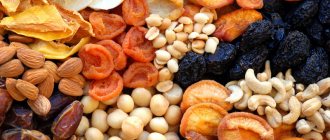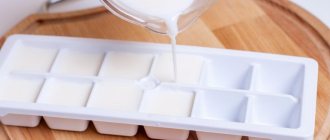Coconut milk is becoming increasingly popular these days. The scope of its application is wide.
In cooking, the product is used for making cocktails, desserts, smoothies, and puree soups; in cosmetology, skin and hair care products are made on its basis.
How to properly store this exotic drink? And if you didn’t use all the milk right away, where can you use it? We will tell you further how you can and cannot store coconut milk.
Can I add coconut milk to coffee?
coconut milk can be replaced with cow's milk in cappuccino, latte and other coffee and milk drinks in the same proportions, but the taste of coconut will not be felt; ... it is better to mix whipped coconut milk with coffee, this will not only give a beautiful airy foam, but also make the taste of the drink softer.
Interesting materials:
What do they eat in Odessa? What do sparrows eat in the wild? What does a worm eat? What is smelt? Should you eat soup or porridge first? What do seals eat in the Arctic? What does a long-eared owl eat? What is there in Lefortovo? What is this resource? What kind of wholemeal bread is this?
General recommendations
Coconut milk is sold in tetra packs or cans.
The packaging indicates the production date and shelf life (usually from 24 to 36 months). Temperature conditions for storing unopened packaging: from +2° to +30° .
When buying a product in a store, choose one with a shorter shelf life. This ensures that it contains fewer preservatives and harmful additives. The ideal drink contains only water and concentrated coconut milk.
In the refrigerator after opening the package
If you open the jar and do not use it all at once, then the remaining contents should be poured into a non-metallic container and kept in the refrigerator . It is not recommended to leave a drink in a tin container!
It is advisable to pour the coconut milk from the Tetropack into a glass container and tightly close the lid. The shelf life of the drink in this form is no more than three days.
Many housewives make the mistake of storing milk in the refrigerator door. Remember that this is the warmest place. And the middle or upper compartment, where the temperature is about 6-8°, is considered ideal for storage.
It should also be taken into account that coconut milk easily absorbs foreign odors. Do not store it near strong-smelling foods (smoked sausages, Korean salads, fish). And don’t forget to tightly close the lid on the milk container. If you prepared the drink yourself at home, then you need to use it within 1-2 days.
In the freezer
It is in vain that some housewives consider freezing not the most successful way to store food. Such food is called “dead”, losing vitamins, beneficial microelements and taste. There are a number of products to which this does not apply in any way. And one of them is coconut milk.
So if you are not going to use the opened milk in the coming days, then you can safely freeze it and then defrost it without fear that the drink will lose its taste.
Basic rules for freezing coconut milk:
It is advisable to freeze the product in small containers. You can use a container or plastic jar, but do not fill it to the top as milk expands when frozen.- Defrosting should be done gradually - do not immediately leave the milk at room temperature, but after putting it in the freezer, keep it on the refrigerator shelf for 24 hours.
- Place a container with completely defrosted coconut milk in hot water for 5-10 minutes, mix the contents well and only then drink or use for cooking.
Coconut milk cannot be re-frozen. A frozen product must be used within 3-4 months.
Frozen coconut milk is great for making smoothies. In this case, it is best to freeze it using ice cube trays.
This is done as follows:
- Pour the drink into molds and place in the freezer.
- Wait until it freezes completely.
- Remove the milk cubes from the molds and place them in a container or plastic bag.
- Place in the freezer again.
This is a very convenient way! When you need to use milk, you defrost exactly as much as you need. Details are in this article.
How much in room conditions?
Store unopened containers of coconut milk at room temperature. But cold rooms (such as pantries, cellars, balconies), where the temperature can drop below +2°, are best avoided. Otherwise, flakes will form in the drink.
Product varieties
The most valuable food product for humans is raw cow's milk, obtained by direct milking and only subjected to purification from impurities through a mechanical filter (gauze) and cooling. The use of aluminum containers for transportation and earthenware for storage allows you to preserve the natural set of elements without a significant change in their proportions, which occurs during contact with various metal and other surfaces during industrial processing and subsequent logistics.
To extend shelf life, the following temperature treatment methods are used, which determine the types of products:
- Pasteurization - consists of one-time heating to a temperature of 600C and subsequent holding for an hour, the duration of which can be halved by increasing the temperature to 70 - 800C. The process is accompanied by the destruction of microorganisms in vegetative form with the preservation of their spores, which necessitates keeping them at a low temperature for a limited time. This process makes it possible to obtain a product with slightly different properties from the original, but with a longer period of preservation of properties.
- Ultrapasteurization is a special case of pasteurization, which consists of short-term heating (1 - 2 seconds) of milk to a temperature in the range of 135 - 1500C, after which it is immediately placed in a room with a temperature of 4 - 50C. The result of processing is the destruction of the vast majority of pathogens.
- Flash pasteurization - HTST technology - consists of controlled heating of a liquid product stream from a temperature of 71.50C to 740C in a limited time in the range from 15 to 30 seconds.
- Sterilization consists of two-stage heating of milk:
- counter flow heated to 750C;
- a stream of dry purified steam in a mixer under excess pressure up to 1400C.
The process of obtaining sterilized milk also includes:
- removal of excess moisture and part of the essential compounds in a vacuum chamber;
- crushing milk fat globules under high pressure in a homogenizer.
As a result of heating to a high temperature, not only harmful microorganisms are destroyed, but also those of value, for example, the content of vitamin C is reduced by at least 30%.
- Freezing involves the gradual crystallization of milk at temperatures from -100C to -180C, which allows you to maintain bactericidal properties at the level of fresh milk for a long period of time.
- Drying is the process of removing moisture from normalized pasteurized milk, amounting to up to 80% of the mass, using spray installations at a temperature of 150 - 1800C to obtain milk powder. The result of the process is a food substance, which is divided depending on the content of components into whole and skim milk powder.
- Reduction is the process of obtaining a liquid substance from a dry substance by mixing with water, whole milk and additives that increase fat content and compensate for the loss of taste. There is a high probability of using vegetable fats.
Milk storage period
Milk in the general sense of the word is a product of the mammary glands of female mammals, including humans. As an object of human consumption, milk is defined as a product of the normal secretion of the mammary glands of livestock, in most cases cows, goats and mares. WITH
Milk contains about 50 different elements of macro- and microstructure, with the following being the most significant:
- calcium, which is an indispensable “building” material for bones and teeth – 100 – 140 mg/100 g;
- magnesium, necessary for the normal growth and development of children, the formation of microflora and resistance to intestinal diseases, as well as the normal development of immunity - 12 - 14 mg/100 g;
- potassium and sodium, necessary in the form of chlorides to maintain normal osmotic blood pressure - 135 - 170 and 30 - 77 mg/100 g, respectively;
- vitamins A, B1, B2, B12, C, D and E are contained in mcg/100 g;
- the content of fats, proteins and carbohydrates can vary from 3 to 6% of the drink;
- Among the microelements, the content of which is determined in µg/100 g of product, there are iron, lead, zinc, chromium, manganese, iodine, selenium, molybdenum, aluminum, cobalt, silicon, tin, fluorine, copper.
Along with components that have a positive effect on human health, milk is characterized by the content of the following ballast substances:
- cholesterol, which increases with increasing product density;
- toxic elements - cadmium, lead, mercury and arsenic;
- aflatoxin;
- pesticides;
- hormones contained only in fresh milk and capable of accelerating or slowing down puberty in girls and boys, respectively;
- and other elements.
Milk is used not only for direct consumption, but also as a raw material for the production of a wide range of food products based on it, including: cottage cheese, cream, fermented milk drinks, sour cream, condensed milk, cheeses, butter, margarine and a number of others.
Is it possible to freeze cream and sour cream?
Sour cream can be frozen
in the freezer!
... Sour cream freezes
easily, its taste remains the same, but its texture changes.
It becomes like crumbly cottage cheese, but this is completely normal.
Frozen sour cream
Interesting materials:
What is variety and nature? What is a type of coffee? What is a composite number example? What is a composite number in mathematics? What is the state of the surrounding world? What is vascular dystonia of the brain? What is vascular dystonia? What is a vascular crisis? What is a social group? What types of groups are there in society? What are social groups? The meaning of social groups?
How can you tell if coconut oil has gone bad?
To ensure that eating coconut only brings pleasant experiences, you should make sure before eating that it is suitable for consumption. It’s easy to find out if a nut has gone bad by the following signs:
- darkening of the outer surface;
- the appearance of stains, dents and traces of mold on the skin (the liquid can disappear and turn sour if the integrity of the skin is damaged);
- drying of the pulp if it has been peeled;
- a dull and heavy sound when shaking milk if the coconut is not opened.
When closed, the nut is stored longer than after opening. You should not clean it prematurely; it is better to do this immediately before eating.
There are several signs by which it is easy to understand that an exotic fruit is spoiled:
- signs of mold are visible on the coconut shell;
- upon opening, a sharp unpleasant odor and bitter taste are felt;
- oil in the solid state changes white to yellow, and in the liquid state it becomes opaque;
- coconut milk separates and grains and lumps appear in it.
Do not peel the fruit in advance; do it immediately before eating. Do not buy a lot of coconuts at once; they have a short shelf life and there is a risk that they will spoil.
The degree of freshness can be determined by the following criteria:
- absence of stains and darkening on its surface;
- peel without cracks or traces of mold;
- juicy pulp (for the opened fruit);
- normal weight and dull sound when shaking the liquid (for a whole coconut).
It is not recommended to peel the nut in advance. It is better to do this before using it. And since the shelf life of coconuts is not very long, it makes no sense to stock up on them in large quantities.
Useful tips
Tips to help when storing the product:
Coconut milk is not a cheap product.
If such a luxury is not permissible, then try making a delicious drink yourself at home. The nut pulp must be carefully cut off, crushed in a blender and poured with warm water (400 ml per 1 coconut). Let it brew a little, squeeze it out with gauze and pour the resulting drink into a container.- Coconut milk cannot be called low-calorie, but it is absorbed by the body better and faster, so it does not have time to be deposited as fat. In addition, this product contains no cholesterol. So for people losing weight, its use is quite acceptable.
- Due to the fat content of coconut drink, it is recommended to dilute it with water. For example, to cook porridge with it, take 1 part milk and 2 more parts water.
- When choosing a coconut drink in the store, give preference to producers from tropical countries. Powdered milk is produced in Russia and Europe.
- Coconut milk should not be boiled, otherwise it will separate into flakes and water.
- You can replace coconut milk in recipes with cow's product with the addition of coconut flakes.
Shelf life of a dairy product according to GOST before and after opening the package
Based on Article 472 of the Civil Code of the Russian Federation, the expiration date is a period of time after which the product cannot be used. The shelf life is set by the manufacturer, while complying with the legal requirements for the conditions of keeping the product.
Article 472 of the Civil Code of the Russian Federation. Product expiration date
- The law or the procedure established by it may provide for the obligation to determine the period after which the product is considered unsuitable for its intended use (expiration date).
- The seller is obliged to transfer a product for which an expiration date has been established to the buyer in such a way that it can be used for its intended purpose before the expiration date, unless otherwise provided by the contract.
According to Decree No. 720 of June 16, 2017 and the Law “On the Protection of Consumer Rights,” the Government of the Russian Federation has established a list of goods that, after the expiration of the period of use, may be dangerous to human health and life. Dairy products are also on this list.
Based on Article 473 of the Civil Code of the Russian Federation, the expiration date can be designated in 2 options:
- Sell by. The exact date of expiration of the period of use is indicated on the packaging, for example, “Expired until July 22, 2024.”
- Good within. This is a time period that is counted from the production date. For example, “Best for 4 months.”
The shelf life of dairy products is determined by GOST 31450-2013 “Drinking milk. Technical conditions". According to the state standard, the shelf life is set by the manufacturer himself, taking into account the requirements of regulatory documents on food safety. Based on Resolution No. 98 of May 22, 2003, the shelf life of dairy products must be justified by the manufacturer of the product.
To confirm them, the manufacturer is obliged to provide government authorities with information on ways to increase the safety of products:
- Improving the quality of raw materials.
- New types of packaging.
- Improving production technology.
- Strengthened sanitary control at the enterprise.
The manufacturer is also obliged to provide test results that confirm the safety of the product for consumption throughout the entire shelf life of the product.
Milk is one of the healthiest products in the human diet. After all, it contains more than 100 elements: minerals, vitamins and amino acids, as well as lactose. But in order not to harm your health, you should be aware of the peculiarities of storing milk depending on its type. We will tell you under what conditions various dairy products can be kept and how their shelf life is affected by the method of heat treatment.
Sukhoi
Powdered milk is obtained by drying a pasteurized milk product. First there is a normalization process. The ratio of proteins, fats and carbohydrates is given in accordance with the requirements of GOST 52738-2007. This is followed by the processes of pasteurization, thickening and drying at a temperature of 150-180°C on special equipment. After drying, the milk is sifted and cooled.
Based on GOST 52791-2007 “Canned milk products. Powdered milk. Technical specifications" products are divided into dry whole and dry low-fat.
- Skim milk powder contains only 1.5% fat and has a shelf life of 36 months.
- The shelf life of whole milk powder is up to 8 months. After opening the package, the product should be consumed within a month.
The period of use of whole milk powder will be shorter than skim milk due to the increased fat content in its composition (25%).
Sterilized
Dairy products are exposed to temperatures above 115°C during sterilization. Such high temperatures destroy milk enzymes and destroy microorganisms and pathogenic spores.
The shelf life of the sterilized drink is up to 6 months if unopened. But after opening the package it must be consumed within 7 days.
Features of use
If you bought coconut milk and, when you get home, want to drink it right away, then you just need to shake it well before drinking . This must be done, because during storage the product separates, that is, water appears at the bottom, and a thick white mass collects at the top. This does not affect the taste in any way.
A container of milk that has been stored in the refrigerator must first be placed in hot water for 5-10 minutes, and then shaken and drunk. Before drinking milk that has been stored in the refrigerator in an open container, you must not only hold it in hot water for 5-10 minutes, but also stir it periodically.
Do not forget that the consumption rate of coconut milk is far from the same as that of cow's milk. For an adult, 100 ml every 3-4 days is enough, for children over 3 years old - no more than 50 ml.
Is it possible to increase the time frame?
If milk is stored in the refrigerator for a long time after opening the can, be sure to check it periodically for signs of spoilage:
- stale taste, reminiscent of tin (this is why it is not recommended to store the product in an open tin container, as coconut milk begins to gradually absorb the smell of the can);
- the surface of the milk is covered with pink mold;
- the product has acquired a grayish color.
To prevent spoilage of an open drink, it is better to immediately pour it into small containers and freeze it. This way you can extend the shelf life up to four months.
What do the resulting flakes indicate?
It happens that when you open a can of coconut drink, you can find flakes formed in it .
This is not yet a reason to think that it has deteriorated. It was simply stored or transported at the wrong temperature (in cold conditions). The buyer has every right to return such product to the point of sale.
The flakes do not have any effect on the taste of the prepared dishes. It is quite acceptable to use such milk for confectionery and baked goods, soups and cereals, cocktails and smoothies. But it is not recommended to add it to granola or coffee, as the flakes will spoil the taste.
How to remove hairs from a coconut?
Removing tough hairs from the surface of coconut shells is not easy.
- if the hairs are thin, cut them using sharp scissors;
- treat the surface with a razor (manual or electric);
- put the coconut in an iron bowl and carefully singe it with a lighter (you need to act very carefully so as not to get burned and prevent the fire from spreading).
How to crack a coconut with a hammer
You will need a plastic bag and a hammer.
- Using a screwdriver or a sharp large nail, make a small hole through which to drain the milk from the nut.
- Place the fruit in a bag and tie it.
- Place the bag on a flat, hard surface (ideally the floor).
- Hit the crust firmly with a hammer.
- After the fruit splits, remove from the bag and remove any remaining skin.
After drying
Dried nut pulp has the longest shelf life. It is about a year. Dried coconut flakes and shavings are best stored in an airtight glass container, or even better in natural fabric bags.
The dishes with the finished product can be placed in the pantry, the main thing is that the place is dark, cool and has good ventilation. But the refrigerator is completely unsuitable for this product. There is too much risk of condensation forming, which can lead to mold.
Before drying, the coconut pulp needs to be crushed, this is best done using a food processor. Drying must be done in an oven preheated to 60 degrees for three hours. After cooling, package as described above. Also, a microwave oven or a special electric dryer is also perfect for drying.
What to do with the product if it is expired?
Do not rush to throw away coconut milk that has expired:
- Use it to cleanse your acne.
- Apply as a mask to strengthen weakened hair.
- To add shine to your curls, combine this milk with coconut oil in equal proportions, add egg yolk and apply the resulting mixture to your hair. After 30 minutes, rinse with warm water.
- Regularly wipe your skin with coconut milk, this can give it elasticity and slow down the aging process.
- If your hair is dry, then combine coconut milk with honey in a 2:1 ratio, and rub the resulting mixture into the skin and distribute along the entire length of the strands. Leave for 1 hour under a warm hood. Repeat the procedure once a week.











